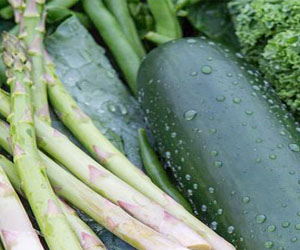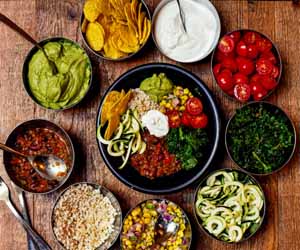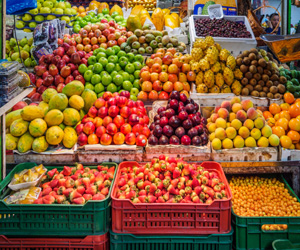


A Delicious Journey Through Nature's Bounty

Seasonal eating is a culinary and environmental philosophy that centers on the consumption of foods that are in season, reflecting the natural rhythms of the year. This approach to food has been embraced for centuries by many cultures around the world, and it's making a resurgence in the modern age due to its numerous benefits for both health and the environment.
Connecting With Nature: Seasonal eating encourages a profound connection with the natural world. When you eat seasonally, you become attuned to the cyclical changes in the environment. You start to anticipate the arrival of certain fruits, vegetables, and other foods and savor their limited-time availability. This heightened awareness fosters a sense of gratitude for the Earth's bounties and a deeper understanding of the delicate balance of nature.
Flavors At Their Peak: Foods that are in season are at their peak in terms of flavor and nutritional value. These foods are harvested at the perfect time, allowing them to develop their full flavor potential. A ripe, in-season tomato, for example, bursts with flavor that is unparalleled in taste when compared to its off-season counterpart. The taste of seasonal produce is a testament to the magic of nature.
Nutritional Benefits: Seasonal eating offers a variety of health benefits. Seasonal fruits and vegetables are rich in essential vitamins, minerals, and antioxidants. Since they are picked at their peak, they often contain more nutrients than out-of-season produce that has been transported long distances or stored for extended periods.
Environmental Sustainability:Embracing seasonal eating also aligns with eco-conscious living. When you choose foods in season, you reduce the need for long-distance transportation and energy-intensive methods of preservation. This, in turn, lowers your carbon footprint and supports local agriculture. It's a sustainable approach that promotes environmental health and resilience.
Diverse And Adventurous Eating: Eating seasonally encourages diversity in your diet. You're constantly introduced to new foods and recipes as you adapt to the changing availability of ingredients. This diversity promotes a balanced and varied diet, which is a key component of a healthy lifestyle.
Community And Local Support: Seasonal eating often leads to supporting local farmers and markets. This strengthens the connection between consumers and producers, fosters local economies, and promotes food security. Purchasing directly from local growers can also be a rewarding experience, as you get to know the people behind your food.
Practical Tips For Seasonal Eating:
Know Your Seasons: Familiarize yourself with the seasons of your region. Learn when specific fruits and vegetables are in season to guide your food choices.
Visit Farmers' Markets: Farmers' markets are excellent places to find fresh, locally grown seasonal produce. They offer a direct link to the source of your food.
Grow Your Own: If you have the space and the inclination, consider starting a garden. Growing your own fruits and vegetables allows you to control the quality of your produce and indulge in the pleasures of harvesting your food.
Preserve The Harvest: During the peak of the season, consider preserving excess fruits and vegetables through canning, freezing, or drying. This will allow you to enjoy seasonal flavors year-round.
Stay Informed: Explore seasonal recipes and get creative with your cooking. Experimenting with new ingredients can be both fun and rewarding.
Seasonal eating is not just a trend; it's a timeless and sustainable way of nourishing both your body and your connection to the world around you. It encourages a deeper appreciation of the natural world, supports local communities, and offers a treasure trove of flavors and nutritional benefits. By aligning your diet with the seasons, you not only savor the delicious tastes of each time of year but also contribute to a healthier planet and a more diverse and vibrant culinary experience.




Health And Dietary Considerations
 Pasta: Traditional wheat-based pasta is a staple of many diets.
Pasta: Traditional wheat-based pasta is a staple of many diets.
Cereals: Wheat is a common ingredient in breakfast cereals.
Flour: Wheat flour is used in baking, cooking, and as a thickening agent in many recipes.
Sauces And Gravies: Some sauces and gravies are thickened with wheat flour.
Beer: Many beers are brewed using wheat, making them unsuitable for those following a wheat-free lifestyle.
Motivations For A Wheat-Free Lifestyle
Celiac Disease: Celiac disease is an autoimmune disorder in which the ingestion of wheat triggers an immune response, leading to damage in the small intestine. Individuals with celiac disease must follow a strict wheat-free diet to manage their condition.
Wheat Allergies: Some individuals experience allergic reactions to wheat, which can range from mild to severe and can include hives, digestive distress, or anaphylaxis.
Non-Celiac Wheat Sensitivity: Non-celiac wheat sensitivity is characterized by adverse reactions to wheat without the autoimmune response seen in celiac disease. Symptoms may include digestive discomfort, fatigue, and headaches.




Nourishing The Planet And Ourselves
 Local And Seasonal Sourcing: Embracing local and seasonal food is another pillar of food sustainability. The transportation of food over long distances generates a substantial carbon footprint. Choosing local and seasonal ingredients reduces greenhouse gas emissions and supports local economies. It also encourages consumers to connect with the natural rhythms of their environment and enjoy a wider variety of fresh, in-season produce.
Local And Seasonal Sourcing: Embracing local and seasonal food is another pillar of food sustainability. The transportation of food over long distances generates a substantial carbon footprint. Choosing local and seasonal ingredients reduces greenhouse gas emissions and supports local economies. It also encourages consumers to connect with the natural rhythms of their environment and enjoy a wider variety of fresh, in-season produce.
Reducing Food Waste: Food sustainability also involves reducing food waste, a significant problem worldwide. By minimizing waste at all stages of the food supply chain, from production to distribution and consumption, we can alleviate the strain on resources and landfills. This requires better planning, innovative packaging, and a shift in consumer behavior.
Healthy Eating: Healthy eating is an integral component of food sustainability. A diet based on nutrient-dense, minimally processed foods contributes to overall well-being and longevity. Sustainable food choices often align with healthier eating patterns, emphasizing fruits, vegetables, whole grains, and lean proteins.
The Crucial Alchemy Behind Perfect Coffee
 The Roasting Machine
The Roasting Machine
Roasting coffee demands specialized equipment known as a coffee roaster. These machines come in various sizes and configurations, from small batch roasters for artisanal micro-roasters to large industrial roasters for mass production. These roasters are equipped with advanced controls to monitor temperature, airflow, and other variables.
The Roasting Process
Drying Phase: The roasting process begins with the drying phase. In this initial stage, the green coffee beans lose moisture and begin to change color from green to yellow. The beans become more brittle, and a grassy smell is often noted.
First Crack: As the roasting temperature continues to rise, the beans undergo a significant change known as the first crack. This is the point at which the beans audibly crack, similar to popcorn. The sugars in the beans begin to caramelize, leading to the development of flavors and the release of carbon dioxide.
Development Phase: After the first crack, the beans enter the development phase. Here, the roaster must closely monitor the roast profile to achieve the desired flavor and aroma.
Celiac Disease, Gluten Sensitivity, And Wheat Allergies
 Common symptoms of celiac disease include gastrointestinal issues like diarrhea, bloating, and abdominal pain, as well as fatigue, anemia, and skin rashes. However, it's important to note that some individuals with celiac disease may experience no noticeable symptoms, making diagnosis challenging. Long-term complications can include malnutrition, osteoporosis, and an increased risk of other autoimmune diseases.
Common symptoms of celiac disease include gastrointestinal issues like diarrhea, bloating, and abdominal pain, as well as fatigue, anemia, and skin rashes. However, it's important to note that some individuals with celiac disease may experience no noticeable symptoms, making diagnosis challenging. Long-term complications can include malnutrition, osteoporosis, and an increased risk of other autoimmune diseases.
Gluten Sensitivity
While celiac disease is a well-defined medical condition, gluten sensitivity, or non-celiac gluten sensitivity (NCGS), is a less clearly understood phenomenon. People with gluten sensitivity experience symptoms similar to those of celiac disease, such as abdominal discomfort, fatigue, and headaches, but do not test positive for celiac disease or wheat allergy. It is often referred to as a "diagnosis of exclusion."
The precise cause of gluten sensitivity remains unclear, but it is thought to be a distinct condition from celiac disease and wheat allergy. Many individuals with NCGS report feeling better on a gluten-free diet, although the mechanism behind these symptoms remains a topic of ongoing research and debate.